#Richard K. Shull
Text
From Wichita to Dodge City, to the O.K. Corral in Tombstone, Wyatt Earp is taught that nothing matters more than family and the law. Joined by his brothers and Doc Holliday, Earp wages war on the dreaded Clanton and McLaury gangs.

Credits: TheMovieDb.
Film Cast:
Wyatt Earp: Kevin Costner
Doc Holliday: Dennis Quaid
Nicholas Earp: Gene Hackman
James Earp: David Andrews
Morgan Earp: Linden Ashby
Ike Clanton: Jeff Fahey
Josie Marcus: Joanna Going
Sheriff Johnny Behan: Mark Harmon
Virgil Earp: Michael Madsen
Allie Earp: Catherine O’Hara
Ed Masterson: Bill Pullman
Big Nose Kate: Isabella Rossellini
Bat Masterson: Tom Sizemore
Bessie Earp: JoBeth Williams
Mattie Blaylock: Mare Winningham
Mr. Sutherland: James Gammon
Frank McLaury: Rex Linn
John Clum: Randle Mell
Tom McLaury: Adam Baldwin
Urilla Sutherland: Annabeth Gish
Curly Bill Brocius: Lewis Smith
Young Wyatt: Ian Bohen
Virginia Earp: Betty Buckley
Lou Earp: Alison Elliott
Sherm McMasters: Todd Allen
Francis O’Rourke: Mackenzie Astin
Warren Earp: Jim Caviezel
Mrs. Sutherland: Karen Grassle
Frank Stillwell: John Dennis Johnston
Sally: Téa Leoni
Ed Ross: Martin Kove
Bob Hatch: Jack Kehler
Pete Spence: Kirk Fox
Johnny Ringo: Norman Howell
Marshal Fred White: Boots Southerland
Indian Charlie: James ‘Scotty’ Augare
Billy Clanton: Gabriel Folse
Billy Claiborne: Kris Kamm
Judge Spicer: John Lawlor
John Shanssey: Michael McGrady
Dr. Seger: Ben Zeller
Stable Hand: Rockne Tarkington
Mayor Wilson: David Doty
Gyp Clements: Matt O’Toole
Saddle Tramp: Brett Cullen
Danny: Owen Roizman
Gambler: Lawrence Kasdan
McGee: Matt Beck
Film Crew:
Costume Design: Colleen Atwood
Original Music Composer: James Newton Howard
Producer: Kevin Costner
Set Decoration: Cheryl Carasik
Production Design: Ida Random
Producer: Lawrence Kasdan
Executive Producer: Charles Okun
Director of Photography: Owen Roizman
Producer: Jim Wilson
Casting: Jennifer Shull
Editor: Carol Littleton
Art Direction: Gary Wissner
Set Designer: Charlie Daboub
Key Costumer: Barry Francis Delaney
Set Designer: Barry Chusid
Music Editor: Jim Weidman
Supervising Sound Editor: Stu Bernstein
Camera Operator: Ian Fox
Executive Producer: Michael Grillo
Hair Supervisor: Marlene D. Williams
Assistant Art Director: Gershon Ginsburg
Executive Producer: Dan Gordon
Camera Operator: Bill Roe
Foley: John Murray
Script Supervisor: Anne Rapp
Second Unit Director of Photography: Richard Bowen
Set Designer: Tom Reta
Dialogue Editor: Lewis Goldstein
Executive Producer: Jon Slan
Makeup Artist: Francisco X. Pérez
Stunts: Gary McLarty
Visual Effects Producer: Robert Stadd
Chief Lighting Technician: Ian Kincaid
Still Photographer: Ben Glass
Dialogue Editor: James Matheny
Costume Supervisor: Cha Blevins
Foley: Dan O’Connell
Property Master: William A. Petrotta
Supervising Sound Editor: Robert Grieve
Sound Re-Recording Mixer: Rick Kline
Sound Re-Recording Mixer: Kevin O’Connell
Construction Coordinator: Greg John Callas
Boom Operator: Joel Shryack
ADR Supervisor: Jessica Gallavan
Hairstylist: Elle Elliott
Dialogue Editor: Alison Fisher
Key Makeup Artist: Gerald Quist
Makeup Supervisor: Michael Mills
ADR Editor: Joe Dorn
Supervising Dialogue Editor: Bobby Mackston
Key Costumer: Ruby K. Manis
Key Grip: Tim Ryan
Location Manager: Paul Hargrave
Key Hair Stylist: Dorothy D. Fox
Steadicam Operator: Rusty Geller
ADR Editor: Stephen Janisz
Rigging Gaffer: Kim Kono
Dolly Grip: David L. Merrill
Costume Supervisor: Le Dawson
Key Costumer: James M. George
Casting Associate: Phil Poulos
Casting Associate: Elizabeth Shull
Movie Reviews:
GenerationofSwine: Tombstone was a different beast, and that sort of overshadows this, given that one tries to be more accurate and the other goes for entertainment.
Take Wyatt Earp as a biopic and it is a superb and fair film. Compare it to Tombstone which was more of a Western and it’s lacking the flair.
However, it ends abruptly, and it is miscast. Cosner (and i am a fan) doesn’t really make a good Earp. Dennis Quaid who I am also a fan of, doesn’t make a good Doc. This was 1994, in the 80s I might have a dif...

View On WordPress
#19th century#Arizona#deputy sheriff#doc holliday#gambling#gunslinger#historical figure#ok corral#sheriff#tombstone arizona#Top Rated Movies#wretch#wyatt earp
0 notes
Text
PRE-, EARLY-, AND LATE-LUCY
July 2, 1967
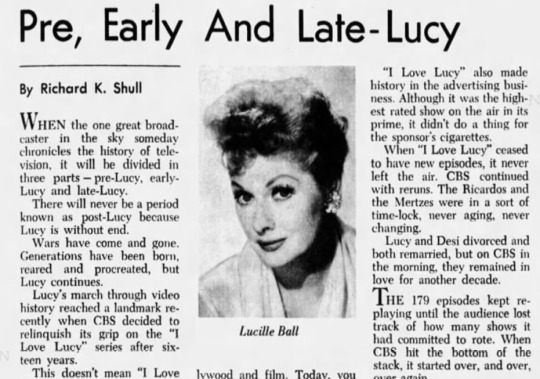
When the one great broadcaster in the sky someday chronicles the history of television, it will be divided in three parts pre-Lucy, early-Lucy and late-Lucy.
There will never be a period known as post-Lucy because Lucy is without end.
Wars have come and gone. Generations have been born, reared and procreated, but Lucy continues. Lucy's march through video history reached a landmark recently when CBS decided to relinquish its grip on the "I Love Lucy" series after sixteen years.
This doesn't mean "I Love Lucy" will disappear from your living room. Rather, it's a rebirth of the ancient series, since it now will be sold station-by-station across the country.
Of course, CBS has Lucille Ball headed for a sixth season in her sequel show, "The Lucy Show," which also appears destined to run practically forever.
More than one third of all Americans living today weren't yet born when "I Love Lucy" made its debut in the fall of 1951 as the star of the CBS line-up.
The show, filmed in a Hollywood studio, turned the TV industry inside out. Until Lucy, television operated with electronic cameras transmitting live programs to a few select cities, with kinescope duplicates for the hinterlands.
After Lucy showed the way, the TV industry moved to Hollywood and film. Today, you can count the non-film TV programs on your fingers. In the beginning, "I Love Lucy" had four stars. Lucille Ball, of course, was the pivotal character. Alongside her was her husband, Desi Arnaz.
And down the hall in their mythical apartment were the Mertzes the late William Frawley and Vivian Vance, who retired from Lucy's new show two years ago to go home to Connecticut.
Desi became a Hollywood tycoon off the "I Love Lucy" show, founded the Desilu Studio complex, then sold out and left Hollywood. Now, he's back and starting a second time around.
Desi Arnaz, Jr., now of the Dino, Desi and Billy rock trio, was virtually born before millions of Lucy fans as Miss Ball played one season enceinte. (And in those days, pregnancy on the screen was unheard of.)
"I Love Lucy" also made history in the advertising business. Although it was the highest rated show on the air in its prime, it didn't do a thing for the sponsor's cigarettes.
When "I Love Lucy" ceased to have new episodes, it never left the air. CBS continued with reruns. The Ricardos and the Mertzes were in a sort of time-lock, never aging, never changing.
Lucy and Desi divorced and both remarried, but on CBS in the morning, they remained in love for another decade.
The 179 episodes kept replaying until the audience lost track of how many shows it had committed to rote. When CBS hit the bottom of the stack, it started over, and over, over again.
This routine might have gone on forever except for an incident in February, 1966, which alerted everyone to the Lucy situation. The network chose to broadcast a fifth rerun of an "I Love Lucy" episode in preference to live testimony from the Senate Foreign Relations Committee's Vietnam hearing. The network's news chief stomped out in a huff.
Last September, CBS retired "I Love Lucy" from daily duty and put it on reserve status.
Then in late March, the decision was made to release "I Love Lucy" from the network and the old episodes were released for sale in syndication to individual stations.
But even before the ink was dry on the contract, the American Federation of Television and Radio Artists called a strike. The network was caught without its live soap operas.
To fill the emergency, naturally, CBS reached up on the shelf and pulled down some battered reels of "I Love You-know-what."
# # #
This article was part of TV Week, a supplement to the Sunday Baltimore (MD) Sun, on July 2, 1967.

That same day (July 2, 1967) Baltimore’s Channel 13 showed The Affairs of Annabel (1938), Lucille Ball’s 39th movie.

On Thursday, July 6, 1967, Baltimore area viewers saw Miss Grant Takes Richmond (1949) on Channel 9. It was Ball’s 72nd film.
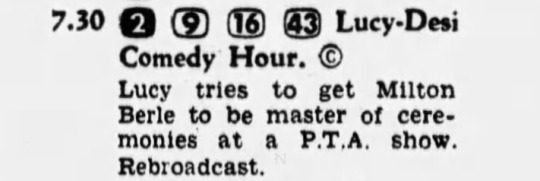
Later that same night, “Milton Berle Hides Out at the Ricardo’s” (LDCH S3;E1), originally aired in September 1959, was on their CBS affiliate. Curiously, there is a small (c) next to the title, which indicates color. This show was not filmed in color.

Interestingly, as the article states, there are no re-runs of “I Love Lucy” on the schedule! But the Ricardos and Mertzes are still visible via “The Lucy-Desi Comedy Hour.”

The headlines that day talked about Canada’s centennial, tensions in the Suez, President Johnson’s relationship with Democratic governors, and America’s precarious financial relationship with Germany.
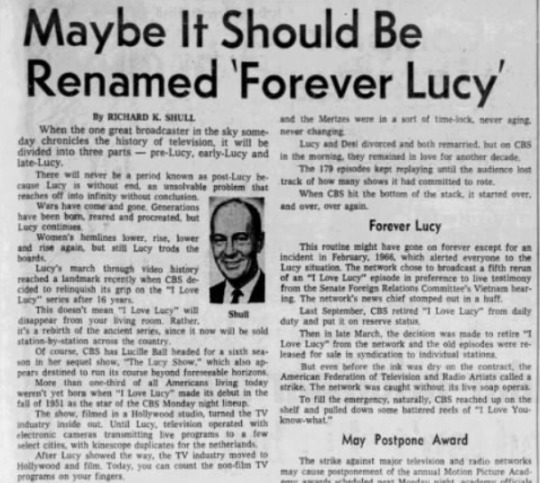
When Shull’s column was printed in other papers, it was often retitled. Headlines were written by the newspapers, not the columnists. Here (The Indianapolis News) they decided on “Maybe It Should Be Renamed ‘Forever Lucy’”. He also got his headshot with this byline.
4 notes
·
View notes
Photo
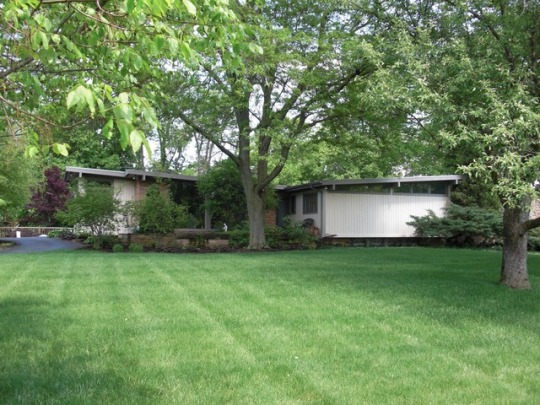
Avril Joy Christie Shulz and the Thornhurst Addition (National Historic Registry).
Avriel Shull 1931-1976 was an American architectural designer/builder and interior decorator from Carmel, Hamilton County, Indiana, whose career spanned from the 1950s until her death in 1976. An energetic and imaginative woman, she is best known for her mid-century modern architectural designs, which are especially unusual given the predominantly traditional tastes of mid-century Indiana. Most of Shull’s projects were single-family homes around Hamilton and Marion counties in central Indiana, most notably the homes in Christie’s Thornhurst Addition in Carmel, Indiana. Shull also designed a number of custom homes in Indianapolis’s toniest suburbs, in other Indiana towns, and in other states. In the 1970s Shull began selling house plans in do-it-yourself home building periodicals, which were sold in the United States and Canada. Shull also designed apartment buildings and commercial/industrial properties. Her first major project outside of Indiana was a public library in Elkins, West Virginia. She also did designs for restaurants, including one in California and one in Carmel, Indiana. Born Avriel Joy Christie in Hamilton County, Indiana, she graduated from Carmel High School and attended Butler University and the John Herron School of Art in Indianapolis, Indiana. She left school in 1948 to launch her own commercial art business. In 1951 she married Richard K. Shull, a well-known Indianapolis journalist who became a syndicated columnist and television critic. The couple had two daughters.
Shull, a self-taught artist without a degree in architecture (in fact with no college degree of any sort), devoted her artistic skills to building projects. A female builder/designer was unique for the time, but even more so was Shull’s lack of formal architectural training. By 1954 Shull had designed and supervised the construction of her first project, the “Golden Unicorn”, a modern-style home in Carmel, Indiana, named after the unicorn installed on an exterior wall. In 1955, Shull began her first large-scale construction project, a new suburban development on a large parcel of land just west of what is now downtown Carmel. Named Christie’s Thornhurst Addition, the subdivision is unusual for its large concentration of Shull’s strikingly-designed homes. In addition to the design work, Shull supervised construction, laying stone on many of the homes’ exteriors herself; coordinated interior design; and assisted in furniture selection. Between 1956 and 1971 Shull designed and built twenty-one houses in Thornhurst. Wiki.
4 notes
·
View notes
Text
Ashe Co. NC Genealogies and Histories #northcarolinapioneers
Ashe County Genealogy Resources: Wills and Estates 1801 to 1903
Ashe County was created 18 November 1799 from Wilkes County. The area that became Ashe County was part of Anson County, Rowan County, Surry County, and Wilkes County. Both Alleghany and Watauga Counties were formed out of Ashe County. The county seat is Jefferson, North Carolina. The Ashe County Courthouse in Jefferson was destroyed by fire in 1865, however, the surviving records are contained here. The Will Books reflect inconsistent years, suggesting that there are gaps due to the loss of records in the fire. Indexes to Probate Records
Book A, 1801 to 1857
Book B, 1828 to 1838
Book C, 1837 to 1941
Book D, 1853 to 1871
Book E, 1873 to 1903
Images of Wills and Estates, Volume A, 1801 to 1857Testators: Adams, John | Alexander, J. W. | Baker, John | Bass, Edward Beal, James | Blackburn, Elizabeth | Blevins, Wells | Brown, James | Brown, William | Burket, Christian | Chambers, Henry | Clampett, George | Clawson, Asa | Cook, Adam | Cook, Michael | Cauncill, Jordan | Debord, Benjamin | Edward, Jane | Eggers, Landrine | Estef, Shadrach | Evans, Barnabas | Farthings, William | Fredway, Robert | Galloway, Elijah | Gambell, Martin | Goodman, Peter | Green, John | Isaacs, James | Jackson, James | Johnson, Jesse | Kenly, Jesse | Landrick, William | Lyall, James | Maxwell, James | Mikel, Daniel | Milanes, William | Mullins, William | Osborn, Mary | Phillips, Mary | Phipps, Samuel | Plummer, Joseph | Powers, M. | Pugh, Julius | Reeces, John | Reeves, Jesse | Ross, Reuben | Sheavers, Robert | Shull, Mary | Shull, Simon | Songs, Samuel | Sturgitt, Francis | Taylor, William | Wagg, John |Walbrooks, Larkin |Whitaker, Peter |Whittington, John |Williams, John |Williams, Lewis | Willis, Leonard |Wyatt, Zebodee Images of Wills and Estates, Volume B, 1828 to 1838Testators: Atkins, John |Brown, John |Brown, Joseph |Brown, Polly | Brown, Thomas | Bryan, Morgan | Callaway, Thomas | Davis, Stanley | Edwards, David | Greer, Aquilla | Hardin, Henry | Hardin, William |Hill, William |Landrith, Nathaniel Latham, Alexander | Mast, David |Moseley, Samuel |Parks, Ambrose | Perry, Robert | Phipps, George | Phillips, Nathan | Ray, James | Stamper, Jonathan | Watters, William | Woodruff, John Images of Wills and Estates, Volume C, 1837 to 1941Testators: Austin, G. B. | Barker, Ambrose | Bean, Jacob | Blevins, Roby | Burgess, Wiley | Calhoun, W. R. | Callaway, J. | Campbell, Mary | Colsand, J. W. | Dalinger, M. | Davis, J. M. | Dolinger, T. L. | Duwall, James | Ellen, W. |Francis, Henry |Gentry, Levi | Grayson, William |Gurley, Thomas |Hall, J. C. |Hardin, R. W. | Hausk, W. H. |Hinley, Lee |Hodgeon, Henry |Houck, Lowery | Jones, B. W. |Jones, Wade |McGuire, H. |McNeil, L. |McMillan, John |Miller, Elizabeth | Miller, H. M. | Miller, J. B. | Monty, John | Osborne, Harris | Parsons, J. | Perkins, G. H. | Phillips, C. W.| Phillips, Nathan | Plummer, J. B. | Pope, J. W. | Prince, R. | Ray, John | Roberts, W. | Roland, J. | Sheets, S. W. Wellborne, William | Weaver, J. R. | Werth, W. H. | Wieseberger, R. | Williams, H. | Williams, Susannah Williamson, Walter Images of Wills and Estates, Volume D, 1853 to 1871Testators: Anderson, Richard | Baker, William | Baldwin, Jacob | Bower, Absalom | Brooks, Thomas | Burket, Christian | Debords, Benjamin | Dickson, Daniel | Dickson, Moses | Doughten, Clarke | Faws, John | Fender, John | Halaway, Daniel | Hardin, Henry | Hill, David | Jenning, William | Johnson, Samuel | Johnson, William Jones, Daniel | Jones, John | Kounce, George | Krawse, John | Landricks, Stephen | Lewis, A. J. | May, John | May, Nancy | Maxwell, Sidney | McMillan, John | Miller, Jonathan | Mullis, James | Oliver, Mary | Perkins, Allen | Perkins, Luther | Perkins, William | Phipps, Samuel | Poe, Jain | Poe, Jaine | Richardson, Elisha | Saunders, Richard | Smith, B. | Smith, Hugh | Smith, James | Turner, Andrew | Wills, David Images of Wills and Estates, Volume E, 1873 to 1903Testators: Allen, John | Ashley, Martha | Ashley, William | Austin, Anderson | Baives, George | Baldwin, William M. | Ballou, N. B. | Ballou, Sarah | Ballou, Susan | Bare, Henry | Barl, Elias Blackburn, Hamilton B. | Blackshear, Hamilton B. | Blevins, Daniel | Blevins, Jackson | Blevins, Jacob | Blevins, John | Blevins, Wells | Bower, George | Boyden, Nathaniel | Brooks, Polly | Brooks, Sentleger | Brown, William | Burgess, Hugh L. | Burgess, Sanders | Burkett, Catherine | Calaway, Thomas | Caloway, Thomas S. | Carson, John | Castle, Nancy | Childers, Hiram | Church, John | Church, Wiley | Conson, John M. | Cook, Charles W. | Cox, Cora | Cox, William | Davis, America | Davis, American | Davis, Daniel | Davis, John | DeBoard, Benjamin | Dewey, Sarah | Dickson, David | Duvall, Thomas | Ellen, Jacob | Elliott, Wilburn | Foster, N. A. | Francis, Mahala | Gambill, James | Garvey, James | Gentry, John | Grimes, Wesley | Goodman, Isaac | Goodman, Jacob | Goodman, Joab | Goodman, William H. | Govert, Frederick | Graham, Jiles | Graybeal, Calvin | Graybeal, Doriel | Graybeal, Eli | Graybeal, Jacob | Graybeal, John | Graybeal, Joseph | Green, John F. | Griffith, John | Griffith, S. | Hagarman, John | Hall, M. Etta | Hamilton, George H. | Hardin, Mark | Hardin, Mary Ann | Hardin, R. T. | Harkins, Johnston | Harvell, Daniel | Hash, James | Hawthorn, Andrew | Howell, George Sr. | Hurley, Harvey C. | Hudler, Joseph | Hurley, James F. | Jacks, Richard | Johnson, Aaron | Johnson, Campbell | Johnson, J. C. | Jones, John | Ketchum, G. W. |King, Joseph | Kitchinson, A. | Koons, Jacob | Lang, Andrew M. | Latham, Silas | Lewallers, Catherine | Lewis, Nancy C. | Little, Isaac | Long, Isaiah | Martin, John W. | Martin, William M. | Mash, James | Mash, William | McClure, Elizar | McGuire, Robert | McMillan, Andrew | McMillan, Iridell Miller, Daniel | Miller, Eli | Miller, James | Miller, Nancy | Miller, William | Moore, W. G. | Neal, John | Neal, Joseph | Neal, Quincy | Oliver, James | Osborne, Alfred | Osborne, Clemons | Osborne, Enoch | Osborne, J. A. | Osborne, Stephen | Parsons, Catharine | Patrick, Jerrymire | Penington, Stephen | Perkins, W. E. | Phillips, Nancy | Phillips, William | Phipp, Greenbury | Phipps, William C. | Pierce, R. K. | Plummer, Nancy | Plummer, Samuel | Poe, John | Poe, Martha | Pope, Elijah | Pope, Elijah (1881) | Price, William | Ray, Jesse | Reedy, Rebecca | Reeves, George W. | Reeves, Rebecca | Reves, John | Reynolds, Terrissa | Richardson, John | Roan, Jonathan | Roark, Joshua | Roland, David | Rominger, Isabella | Rotan, Larkin | Scott, James | Senters, N. M. | Shepherd, J. W. | Shepard, Levi | Shepherd, Melvin | Smith, James | Smith, Tobias | Stamper, John | Stephens, Gardner | Stuart, Newel | Stump, Christopher C. | Tatum, Joseph | Taylor, Charles | Taylor, Hellen | Taylor, Mary | Taylor, William | Tegue, Moses | Testerman, Peter | Thomas, W. T. | Thompson, Alexander | Thompson, Wesley | Turner, Standiford | Turner, William | Vany, John H. | Wagoner, Henry | Warren, Peter M. | Wayman, Thomas | Waters, William | Waugh, James P. | Waugh, James P. (1891) | Weaver, B. M. | Weaver, Gideon | Welch, James | Weymer, Henry | Williams, Nancy | Worth, David | Wyatt, John | Wyatt, William | Yates, E. C. | Yates, Squire Allen
Find your Ancestors Records on North Carolina Pioneers
SUBSCRIBE HERE
via Blogger http://ift.tt/2xNFitz
0 notes
Photo

Avril Joy Christie Shulz and the Thornhurst Addition (National Historic Registry).
Avriel Shull 1931-1976 was an American architectural designer/builder and interior decorator from Carmel, Hamilton County, Indiana, whose career spanned from the 1950s until her death in 1976. An energetic and imaginative woman, she is best known for her mid-century modern architectural designs, which are especially unusual given the predominantly traditional tastes of mid-century Indiana. Most of Shull’s projects were single-family homes around Hamilton and Marion counties in central Indiana, most notably the homes in Christie’s Thornhurst Addition in Carmel, Indiana. Shull also designed a number of custom homes in Indianapolis’s toniest suburbs, in other Indiana towns, and in other states. In the 1970s Shull began selling house plans in do-it-yourself home building periodicals, which were sold in the United States and Canada. Shull also designed apartment buildings and commercial/industrial properties. Her first major project outside of Indiana was a public library in Elkins, West Virginia. She also did designs for restaurants, including one in California and one in Carmel, Indiana. Born Avriel Joy Christie in Hamilton County, Indiana, she graduated from Carmel High School and attended Butler University and the John Herron School of Art in Indianapolis, Indiana. She left school in 1948 to launch her own commercial art business. In 1951 she married Richard K. Shull, a well-known Indianapolis journalist who became a syndicated columnist and television critic. The couple had two daughters.
Shull, a self-taught artist without a degree in architecture (in fact with no college degree of any sort), devoted her artistic skills to building projects. A female builder/designer was unique for the time, but even more so was Shull’s lack of formal architectural training. By 1954 Shull had designed and supervised the construction of her first project, the “Golden Unicorn”, a modern-style home in Carmel, Indiana, named after the unicorn installed on an exterior wall. In 1955, Shull began her first large-scale construction project, a new suburban development on a large parcel of land just west of what is now downtown Carmel. Named Christie’s Thornhurst Addition, the subdivision is unusual for its large concentration of Shull’s strikingly-designed homes. In addition to the design work, Shull supervised construction, laying stone on many of the homes’ exteriors herself; coordinated interior design; and assisted in furniture selection. Between 1956 and 1971 Shull designed and built twenty-one houses in Thornhurst. Wiki.
3 notes
·
View notes
Photo
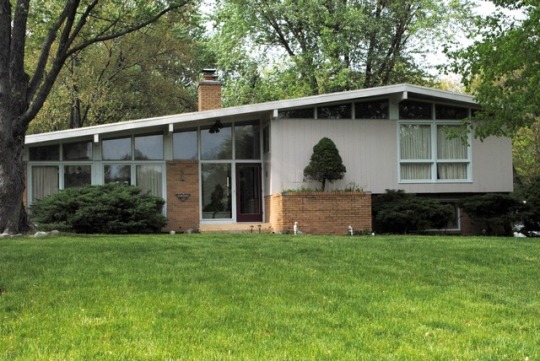
Avril Joy Christie Shulz and the Thornhurst Addition (National Historic Registry).
Avriel Shull 1931-1976 was an American architectural designer/builder and interior decorator from Carmel, Hamilton County, Indiana, whose career spanned from the 1950s until her death in 1976. An energetic and imaginative woman, she is best known for her mid-century modern architectural designs, which are especially unusual given the predominantly traditional tastes of mid-century Indiana. Most of Shull’s projects were single-family homes around Hamilton and Marion counties in central Indiana, most notably the homes in Christie’s Thornhurst Addition in Carmel, Indiana. Shull also designed a number of custom homes in Indianapolis’s toniest suburbs, in other Indiana towns, and in other states. In the 1970s Shull began selling house plans in do-it-yourself home building periodicals, which were sold in the United States and Canada. Shull also designed apartment buildings and commercial/industrial properties. Her first major project outside of Indiana was a public library in Elkins, West Virginia. She also did designs for restaurants, including one in California and one in Carmel, Indiana. Born Avriel Joy Christie in Hamilton County, Indiana, she graduated from Carmel High School and attended Butler University and the John Herron School of Art in Indianapolis, Indiana. She left school in 1948 to launch her own commercial art business. In 1951 she married Richard K. Shull, a well-known Indianapolis journalist who became a syndicated columnist and television critic. The couple had two daughters.
Shull, a self-taught artist without a degree in architecture (in fact with no college degree of any sort), devoted her artistic skills to building projects. A female builder/designer was unique for the time, but even more so was Shull’s lack of formal architectural training. By 1954 Shull had designed and supervised the construction of her first project, the “Golden Unicorn”, a modern-style home in Carmel, Indiana, named after the unicorn installed on an exterior wall. In 1955, Shull began her first large-scale construction project, a new suburban development on a large parcel of land just west of what is now downtown Carmel. Named Christie’s Thornhurst Addition, the subdivision is unusual for its large concentration of Shull’s strikingly-designed homes. In addition to the design work, Shull supervised construction, laying stone on many of the homes’ exteriors herself; coordinated interior design; and assisted in furniture selection. Between 1956 and 1971 Shull designed and built twenty-one houses in Thornhurst. Wiki.
3 notes
·
View notes
Photo

Avril Joy Christie Shulz and the Thornhurst Addition (National Historic Registry).
Avriel Shull 1931-1976 was an American architectural designer/builder and interior decorator from Carmel, Hamilton County, Indiana, whose career spanned from the 1950s until her death in 1976. An energetic and imaginative woman, she is best known for her mid-century modern architectural designs, which are especially unusual given the predominantly traditional tastes of mid-century Indiana. Most of Shull’s projects were single-family homes around Hamilton and Marion counties in central Indiana, most notably the homes in Christie’s Thornhurst Addition in Carmel, Indiana. Shull also designed a number of custom homes in Indianapolis’s toniest suburbs, in other Indiana towns, and in other states. In the 1970s Shull began selling house plans in do-it-yourself home building periodicals, which were sold in the United States and Canada. Shull also designed apartment buildings and commercial/industrial properties. Her first major project outside of Indiana was a public library in Elkins, West Virginia. She also did designs for restaurants, including one in California and one in Carmel, Indiana. Born Avriel Joy Christie in Hamilton County, Indiana, she graduated from Carmel High School and attended Butler University and the John Herron School of Art in Indianapolis, Indiana. She left school in 1948 to launch her own commercial art business. In 1951 she married Richard K. Shull, a well-known Indianapolis journalist who became a syndicated columnist and television critic. The couple had two daughters.
Shull, a self-taught artist without a degree in architecture (in fact with no college degree of any sort), devoted her artistic skills to building projects. A female builder/designer was unique for the time, but even more so was Shull’s lack of formal architectural training. By 1954 Shull had designed and supervised the construction of her first project, the “Golden Unicorn”, a modern-style home in Carmel, Indiana, named after the unicorn installed on an exterior wall. In 1955, Shull began her first large-scale construction project, a new suburban development on a large parcel of land just west of what is now downtown Carmel. Named Christie’s Thornhurst Addition, the subdivision is unusual for its large concentration of Shull’s strikingly-designed homes. In addition to the design work, Shull supervised construction, laying stone on many of the homes’ exteriors herself; coordinated interior design; and assisted in furniture selection. Between 1956 and 1971 Shull designed and built twenty-one houses in Thornhurst. Wiki.
2 notes
·
View notes
Photo
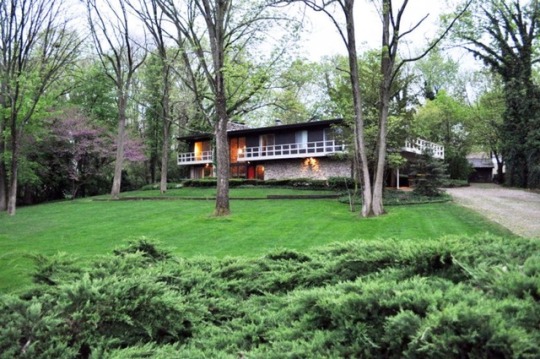
Avril Joy Christie Shulz and the Thornhurst Addition (National Historic Registry).
Avriel Shull 1931-1976 was an American architectural designer/builder and interior decorator from Carmel, Hamilton County, Indiana, whose career spanned from the 1950s until her death in 1976. An energetic and imaginative woman, she is best known for her mid-century modern architectural designs, which are especially unusual given the predominantly traditional tastes of mid-century Indiana. Most of Shull’s projects were single-family homes around Hamilton and Marion counties in central Indiana, most notably the homes in Christie’s Thornhurst Addition in Carmel, Indiana. Shull also designed a number of custom homes in Indianapolis’s toniest suburbs, in other Indiana towns, and in other states. In the 1970s Shull began selling house plans in do-it-yourself home building periodicals, which were sold in the United States and Canada. Shull also designed apartment buildings and commercial/industrial properties. Her first major project outside of Indiana was a public library in Elkins, West Virginia. She also did designs for restaurants, including one in California and one in Carmel, Indiana. Born Avriel Joy Christie in Hamilton County, Indiana, she graduated from Carmel High School and attended Butler University and the John Herron School of Art in Indianapolis, Indiana. She left school in 1948 to launch her own commercial art business. In 1951 she married Richard K. Shull, a well-known Indianapolis journalist who became a syndicated columnist and television critic. The couple had two daughters.
Shull, a self-taught artist without a degree in architecture (in fact with no college degree of any sort), devoted her artistic skills to building projects. A female builder/designer was unique for the time, but even more so was Shull’s lack of formal architectural training. By 1954 Shull had designed and supervised the construction of her first project, the “Golden Unicorn”, a modern-style home in Carmel, Indiana, named after the unicorn installed on an exterior wall. In 1955, Shull began her first large-scale construction project, a new suburban development on a large parcel of land just west of what is now downtown Carmel. Named Christie’s Thornhurst Addition, the subdivision is unusual for its large concentration of Shull’s strikingly-designed homes. In addition to the design work, Shull supervised construction, laying stone on many of the homes’ exteriors herself; coordinated interior design; and assisted in furniture selection. Between 1956 and 1971 Shull designed and built twenty-one houses in Thornhurst. Wiki.
2 notes
·
View notes